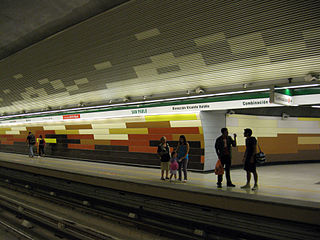
San Pablo is a rapid transit complex in the Santiago Metro, located in Lo Prado. Lines 1 and 5 stop there, being the western terminus of the former.

Los Héroes is a rapid transit station of the Santiago Metro system, being an interchange point in between lines 1 and Santiago Metro Line 2. It located at the intersection of Avenida Libertador General Bernardo O'Higgins and the Norte-Sur branch of the Autopista Central, which is considered the kilometre zero of Chile.

Baquedano is a transfer station between the Line 1 and Line 5 of the Santiago Metro. It is located close to the eastern terminus of the Avenida Libertador General Bernardo O'Higgins. The station was initially a single-line station on the Line 1, later was enlarged since the Line 5's opening date. there are plans for the future line 7 to intersect with this station.

Bellas Artes is an underground metro station on the Line 5 of the Santiago Metro. It has platforms narrower than those of the older Santiago's metro stations and has only one exit. Chilean National Museum of Fine Arts, which is located on Parque Forestal, and Santa Lucía Hill are within walking distance from the station. The station was opened on 3 March 2000 as part of the extension of the line was extended from Baquedano to Santa Ana.

Salvador is an underground metro station on the Line 1 of the Santiago Metro, in Santiago, Chile. The station is located beneath the Balmaceda Park and close to Salvador Avenue, which is named for the Hospital del Salvador. The station was opened on 31 March 1977 as the eastern terminus of the extension of the line from La Moneda. On 22 August 1980 the line was extended further east to Escuela Militar.

Escuela Militar is an underground metro station on the Line 1 of the Santiago Metro, in Santiago, Chile. It is located beneath the cloverleaf-like interchange of Apoquindo Avenue and Américo Vespucio Avenue. The station was opened on 22 August 1980 as part of the extension of the line from Salvador to Escuela Militar. It remained the eastern terminus of the Line 1 until 7 January 2010, when the line was extended to Los Dominicos, and is named for the nearby Escuela Militar del Libertador Bernardo O'Higgins.

Parque Bustamante is an underground metro station on the Line 5 of the Santiago Metro, in Santiago, Chile. It is located beneath Parque Bustamante, which gives the name to the station. The station was opened on 5 April 1997 as part of the inaugural section of the line, from Baquedano to Bellavista de La Florida.
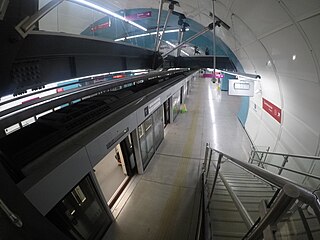
Los Leones is a station of the line 1 of the Santiago Metro in Chile, and is the northern terminus of the line 6. The station is named for the nearby Los Leones Avenue. Located in the heart of the commercial area of Providencia, some of its entrances are integrated into the retail lower levels of buildings.

El Golf is an underground metro station on the Line 1 of the Santiago Metro, in Santiago, Chile. It is located in El Golf neighborhood, close to the building that serves as the seat of local government for Las Condes. The station was opened on 22 August 1980 as part of the extension of the line from Salvador to Escuela Militar.
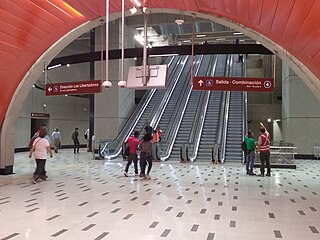
Plaza Egaña is a transfer station between the Line 3 and Line 4 of the Santiago Metro. It is located under Egaña Square. The Line 4 station was opened on 30 November 2005 as part of the inaugural section of the line between Tobalaba and Grecia. The Line 3 station was opened on 22 January 2019 as part of the inaugural section of the line, from Los Libertadores to Fernando Castillo Velasco.

Gruta de Lourdes is an underground metro station on the Line 5 of the Santiago Metro, in Santiago, Chile. It is located close to the western branch of the Autopista Central and the Basilica of Lourdes. East of the station, Line 5 runs beneath Quinta Normal Park. The station was opened on 12 January 2010 as part of the extension of the line from Quinta Normal to Pudahuel.

Santiago Metro Line 1 is the oldest of the seven existing rapid transit lines that make up the Santiago Metro system. Being its busiest, it has a total of 27 stations along its 19.3 km (12.0 mi) length, constructed almost entirely underground, and is located primarily along the axis formed by the Avenida Libertador General Bernardo O'Higgins, Providencia Avenue and Apoquindo Avenue.
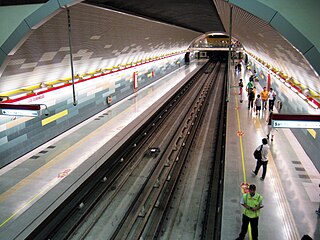
Los Dominicos is a metro station on Line 1 of the Santiago Metro in Santiago, Chile, and is also the eastern terminal of this line.
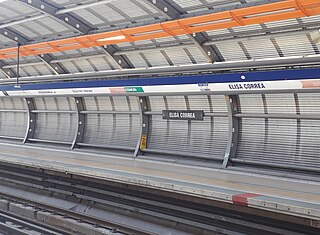
Elisa Correa station is an elevated metro station located on the overhead section of Line 4 of the Santiago Metro, in Santiago, Chile. The station is located on the boundary between the communes of Puente Alto and La Florida, and is the last station of the line 4 on the Cordillera province heading into the center of Santiago. It is named after the street where it is located, the junction of Elisa Correa Sanfuentes Street to the west, Los Toros Venue to the east and Vicuña Mackenna Avenue to the north and Concha y Toro Avenue to the south.

Hospital Sótero del Río station is an elevated metro station located on the overhead section of Line 4 of the Santiago Metro, in Santiago, Chile. It is named after the Sótero del Río Hospital, which is directly surrounding the station. The station is located in Concha y Toro Avenue near its junction with Gabriela Avenue.

San Ramón station is a metro station located on Line 4A of the Santiago Metro in Santiago, Chile between Santa Rosa and La Cisterna station. It lies along the Vespucio Sur Freeway, near its junction with Almirante Latorre Street. The station has disabled access. The station was opened on 16 August 2006 as part of the inaugural section of the line between Vicuña Mackenna and La Cisterna.
Santa Rosa station is an embanked metro station located on Line 4A of the Santiago Metro in Santiago, Chile, between the La Granja and San Ramón stations and also between the communes of the same names La Granja and San Ramón. It lies along the Vespucio Sur Freeway, on its junction with Santa Rosa Avenue. The station was opened on 16 August 2006 as part of the inaugural section of the line between Vicuña Mackenna and La Cisterna.
Santa Julia station is an embanked metro station located on Line 4A of the Santiago Metro in Santiago, Chile, between Vicuña Mackenna station and La Granja station in the commune of La Florida. It lies along the Vespucio Sur Freeway at the junction with Santa Julia Street. The station was opened on 16 August 2006 as part of the inaugural section of the line between Vicuña Mackenna and La Cisterna.

Cerrillos is an underground metro station and the southern terminal station of Line 6 of the Santiago Metro network, in Santiago, Chile. It is underground, being the terminal station of Line 6, preceded by the Lo Valledor station. It is located at the intersection of Pedro Aguirre Cerda-Camino a Melipilla avenues with Departamental-Buzeta. The station was opened on 2 November 2017 as part of the inaugural section of the line, between Cerrillos and Los Leones.
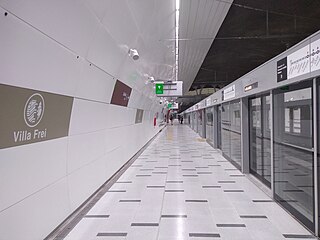
Villa Frei is an underground metro station of Line 3 of the Santiago Metro network, in Santiago, Chile. It is an underground, between the Chile España and Plaza Egaña stations on Line 3. It is located at the intersection of Irarrázaval Avenue with Ramón Cruz Avenue. The station was opened on 22 January 2019 as part of the inaugural section of the line, from Los Libertadores to Fernando Castillo Velasco.



















